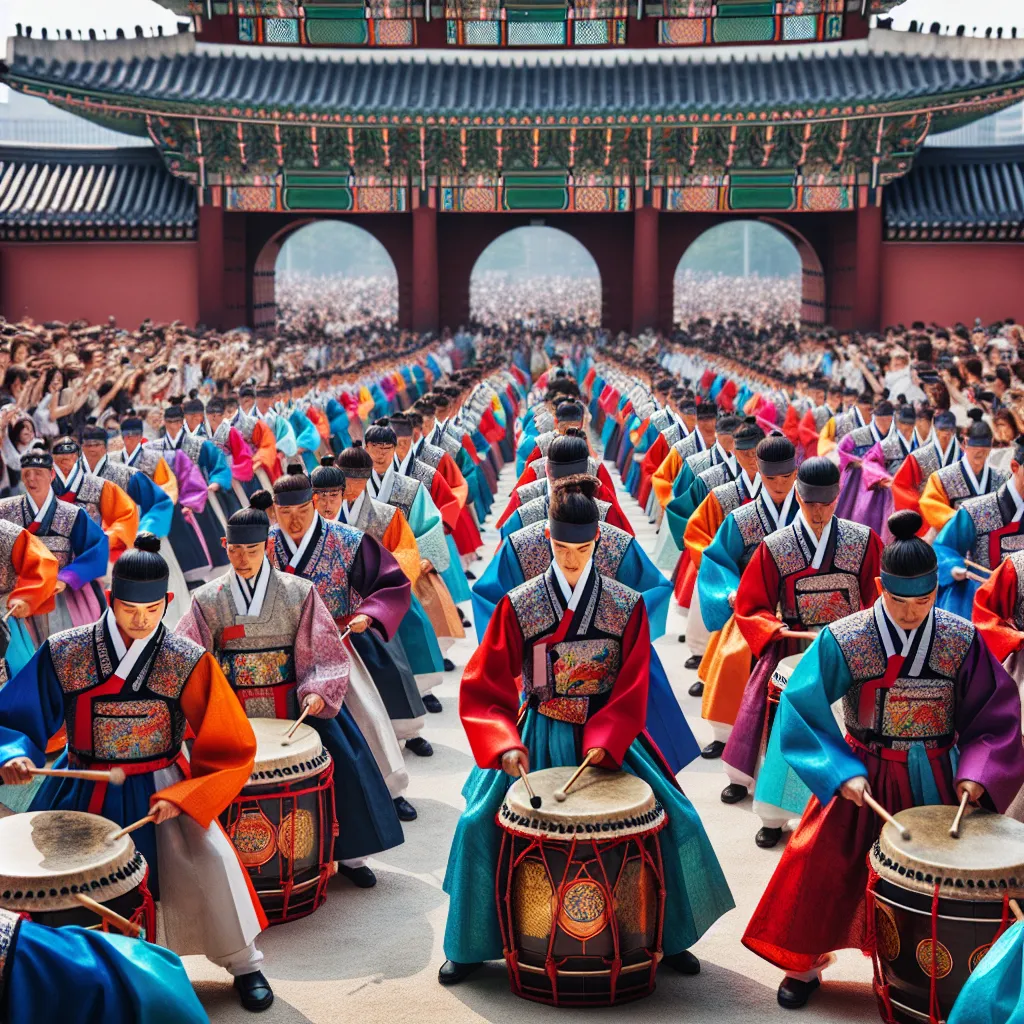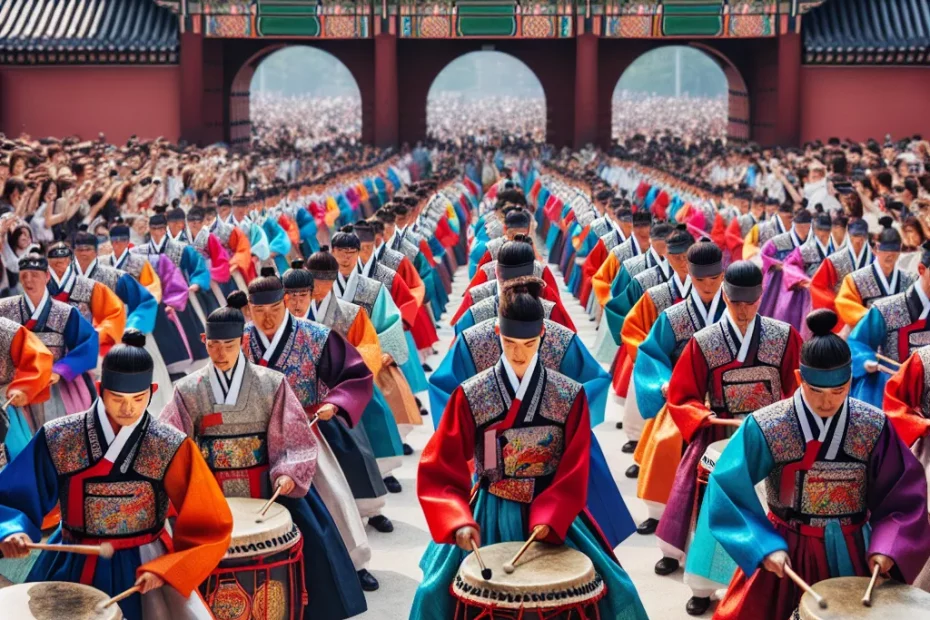As you step into the grandeur of Gwanghwamun Gate in Seoul, South Korea, you are transported back in time to an era of tradition and honor. The ceremonious changing of the guards at this historic site offers visitors a glimpse into the rich cultural heritage of Korea. The rhythmic beat of traditional drums and the vibrant colors of hanbok create a mesmerizing ambiance, captivating all who witness this time-honored ritual. Visitors are not merely spectators but participants in a centuries-old tradition, where respect and etiquette are paramount. Experiencing the Guard Changing Ceremony at Gwanghwamun Gate is not just a sightseeing opportunity but a chance to immerse oneself in the essence of Korean tradition and history.

History of Gwanghwamun Gate
Located in the heart of Seoul, South Korea, Gwanghwamun Gate stands as a symbol of the country’s rich history and cultural heritage. Built during the Joseon Dynasty in 1395, this majestic gate served as the main entrance to Gyeongbokgung Palace, the primary royal residence of the dynasty. With its intricate architectural design and historical significance, Gwanghwamun Gate has witnessed centuries of political changes, invasions, and cultural transformations.
The Meaning of Gwanghwamun Gate
The gate, which means “may the light of enlightenment blanket the world,” has undergone several reconstructions due to various wars and fires throughout its history. The current structure, reconstructed in 1968, faithfully replicates the original design, showcasing the traditional Korean architectural style of the Joseon Dynasty. Standing at a height of 14.2 meters and stretching 12.5 meters wide, Gwanghwamun Gate continues to attract visitors from around the world, eager to witness its grandeur and historical importance.
Symbol of Power and National Identity
Throughout the centuries, Gwanghwamun Gate has played a crucial role in Korean history, serving as a symbol of power, resilience, and national identity. It has witnessed royal processions, official ceremonies, and important announcements, making it a focal point of political and cultural life in Korea. The gate’s significance extends beyond its architectural beauty, representing the enduring spirit of the Korean people and their commitment to preserving their heritage.
Changing of the Gate Guards Ceremony
As a testament to its cultural importance, Gwanghwamun Gate is also home to the changing of the gate guards ceremony, known as “Sumungun.” This traditional ritual, which takes place every hour from 10 a.m. to 4 p.m., showcases the precision, discipline, and honor of the Korean military. Visitors can witness the guards dressed in colorful traditional uniforms, performing intricate martial arts movements as they change shifts, a spectacle that highlights Korea’s rich martial traditions and cultural practices.
Legacy and Heritage
In conclusion, Gwanghwamun Gate stands as a timeless monument to Korea’s past, present, and future. Its historical significance, architectural beauty, and cultural importance make it a must-visit destination for anyone seeking to delve into the rich tapestry of Korean history and tradition. Witnessing the changing of the gate guards ceremony at Gwanghwamun Gate provides a glimpse into Korea’s proud heritage and the enduring legacy of its people.
Significance of Guard Changing Ceremony
The Guard Changing Ceremony at Gwanghwamun Gate in Seoul, South Korea, is not just a simple tradition; it is a symbolic representation of Korea’s rich history, cultural heritage, and national pride. This ceremony, which has been taking place for centuries, holds immense significance in Korean society and beyond.
Historical Legacy
The ceremony dates back to the Joseon Dynasty, showcasing the military discipline and loyalty to the king. It serves as a reminder of Korea’s past, honoring the sacrifices and dedication of the guards who protected the royal palace.
Cultural Preservation
Through the meticulous rituals and traditional attire worn by the guards, the ceremony preserves and promotes Korea’s cultural identity. It allows both locals and visitors to experience a glimpse of Korea’s ancient traditions and customs.
Tourist Attraction
The Guard Changing Ceremony has become a major tourist attraction, drawing visitors from around the world. It offers a unique opportunity for cultural exchange and promotes tourism in Seoul, contributing to the city’s economy.
Symbol of National Pride
The ceremony symbolizes national pride and unity, showcasing the strength and resilience of the Korean people. It instills a sense of patriotism and respect for the country’s history and traditions.
Celebration of Excellence
The guards undergo rigorous training to perform the ceremony with precision and grace. It highlights the importance of discipline, teamwork, and dedication, serving as a tribute to excellence in all endeavors.
In conclusion, the Guard Changing Ceremony at Gwanghwamun Gate is not just a routine event; it is a powerful symbol of Korea’s past, present, and future. By witnessing this ceremony, one can truly appreciate the significance of tradition, culture, and national pride in Korean society.
Traditional Korean Clothing and Instruments
In the grandeur of the Gwanghwamun Gate Guards Changing Ceremony, one cannot help but be captivated by the traditional Korean clothing and instruments that adorn the event. The guards, dressed in vibrant and meticulously crafted Hanbok, showcase the rich cultural heritage of Korea with each movement. The intricate designs and colors of their attire symbolize not just fashion, but a deep-rooted history that dates back centuries.
Hanbok: Elegance and Grace
The Hanbok, with its flowing silhouettes and bold hues, reflects the elegance and grace of Korean tradition. The guards’ attire is meticulously detailed, from the Jeonbok (long vest) to the Baji (pants) and Durumagi (overcoat), each piece carefully chosen to represent a specific aspect of Korean culture. The vibrant colors such as red, blue, and yellow are not just for aesthetic purposes but hold symbolic meanings tied to Korean cosmology and social hierarchy.
Traditional Korean Instruments: Melodic Sounds
As the guards perform the ceremonial rituals, the melodic sounds of traditional Korean instruments fill the air, adding another layer of authenticity to the event. The Janggu, a traditional double-headed drum, sets the rhythm, while the haunting melodies of the Daegeum (bamboo flute) and the Gayageum (zither) create a mesmerizing atmosphere. These instruments, with their unique timbres and intricate techniques, have been passed down through generations, preserving the essence of Korean music.
The combination of traditional Korean clothing and instruments during the Gwanghwamun Gate Guards Changing Ceremony offers a glimpse into the cultural richness and artistic mastery of Korea. It is not just a performance but a living testament to the enduring traditions that continue to thrive in the modern world. The meticulous attention to detail in both attire and music showcases the dedication and pride that Koreans have for their heritage, making the ceremony a truly immersive experience for both locals and visitors alike.
Witnessing the guards in their Hanbok and hearing the soul-stirring melodies of the traditional instruments, one cannot help but be transported back in time to an era of kings and queens, scholars and warriors. The Gwanghwamun Gate Guards Changing Ceremony serves as a reminder of Korea’s vibrant past and a celebration of its cultural identity. It is a spectacle that not only entertains but educates, offering a window into the traditions and customs that have shaped Korean society for centuries.
In conclusion, the traditional Korean clothing and instruments showcased during the Gwanghwamun Gate Guards Changing Ceremony are not just symbols of the past, but living embodiments of a culture that continues to thrive and evolve. The intricate designs, vibrant colors, and soulful melodies serve as a testament to the enduring legacy of Korean heritage, captivating audiences and preserving tradition for generations to come. ~🎶🇰🇷👘
Visitor Experience and Etiquette
Welcome to the Gwanghwamun Gate Guards Changing Ceremony, a traditional event that offers a fascinating glimpse into Korean culture and history. As you prepare to witness this unique ceremony, it is important to keep in mind certain etiquette guidelines to ensure a respectful and enjoyable experience.
Arrival and Viewing
First and foremost, visitors are encouraged to arrive early to secure a good viewing spot. The ceremony tends to attract a large crowd, so being punctual will allow you to fully appreciate the intricate details of the event. Additionally, please refrain from blocking the view of others or disrupting the solemn atmosphere with loud noises or distractions.
Ceremony Etiquette
As the ceremony begins, you will be captivated by the precision and grace of the gate guards as they perform their intricate movements. It is customary to remain silent during the ceremony as a sign of respect for the traditions being showcased. Feel free to take photos, but do so discreetly and without disturbing the flow of the event.
Costumes and Symbolism
One of the highlights of the ceremony is the colorful attire worn by the gate guards. Their vibrant costumes are steeped in symbolism and history, adding an extra layer of significance to the proceedings. Take a moment to appreciate the craftsmanship and attention to detail that goes into each garment.
Interaction with Gate Guards
After the ceremony concludes, you may have the opportunity to interact with the gate guards and learn more about their roles and responsibilities. Feel free to ask questions, but remember to do so politely and with a genuine interest in their culture and traditions. A friendly demeanor and open mind will go a long way in enhancing your overall experience.
In conclusion, the Gwanghwamun Gate Guards Changing Ceremony offers a unique opportunity to immerse yourself in Korean heritage and tradition. By following these etiquette guidelines and approaching the event with an open heart and mind, you are sure to have a memorable and enriching experience. Enjoy the ceremony and savor every moment of this cultural extravaganza! 🌟🇰🇷
Immerse yourself in the rich cultural heritage of Korea by witnessing the captivating Guard Changing Ceremony at Gwanghwamun Gate. Experience the history and tradition of this ancient ritual as the guards, dressed in colorful traditional attire, perform intricate movements to the sound of traditional Korean instruments. Visitors are encouraged to observe with respect and immerse themselves in the solemn atmosphere. This ceremony offers a unique opportunity to glimpse into Korea’s past and appreciate the significance of its cultural traditions. Witnessing this ceremony is not just a sightseeing experience, but a journey through time that allows you to connect with Korea’s history and traditions on a deeper level.
